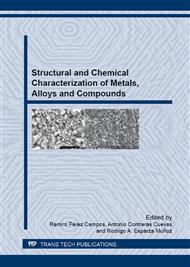[1]
Information on http: /www. paldat. org.
Google Scholar
[2]
S.J. Bonvehí, S.M. Torrentó and C.E. Lorente, Evaluation of polyphenolic and flavonoid compounds in honeybee-collected pollen produced in Spain, J. Agric. Food Chem. 49 (2001) 1848-1853.
DOI: 10.1021/jf0012300
Google Scholar
[3]
P. Piffanelli, J.H.E. Ross and D. J. Murphy, Biogenesis and function of the lipidic structures of pollen grains, Sex Plant Reprod. 11 (1998) 65-80.
DOI: 10.1007/s004970050122
Google Scholar
[4]
R. Shakya and S.C. Bhatla, A comparative analysis of the distribution and composition of lipidic constituents and associated enzymes in pollen and stigma of sunflower, Sex Plant Reprod. 23 (2010) 163-172.
DOI: 10.1007/s00497-009-0125-0
Google Scholar
[5]
S. Schulz, C. Arsene, M. Tauber and J.N. McNeil, Composition of lipids from sunflower pollen (Helianthus annuus), Phytochemistry 54 (2000) 325-336.
DOI: 10.1016/s0031-9422(00)00089-3
Google Scholar
[6]
A.F. Edlund, R. Swanson and D. Preuss, Pollen and stigma structure and function: The role of diversity in pollination, The Plant Cell 16 (2004) S84-S97.
DOI: 10.1105/tpc.015800
Google Scholar
[7]
M. Fambrini, V. Michelotti and C. Pugliesi, Orange, yellow and white-cream: inheritance of carotenoid-based colour in sunflower pollen, Plant Biology 12 (2010) 197-205.
DOI: 10.1111/j.1438-8677.2009.00205.x
Google Scholar
[8]
T. Kokubo, H. Kushitani, Y. Abe, T. Kitsugi and T. Yamamuro, Apatite coatings on various substratesin simulated body fluids, Bioceramics 2 (1989) 235-242.
Google Scholar
[9]
S.H. Rhee and J. Tanaka, Hydroxyapatite formation on cellulose cloth induced by citric acid, J. Mater. Sci.: Mater. Med. 11 (2000) 449-452.
Google Scholar
[10]
A.C. Tas and S.B. Bhaduri, Rapid coating of Ti6Al4V at room temperature with a calcium phosphate solution similar to 10× simulated body fluid, J. Mater. Res. 19 (2004) 2742-2749.
DOI: 10.1557/jmr.2004.0349
Google Scholar
[11]
J. Richter, M. Mertig, W. Pompe, I. Monch and H.K. Schackert, Construction of highly conductive nanowires on a DNA template, Appl. Phys. Lett. 78 (2001) 536-538.
DOI: 10.1063/1.1338967
Google Scholar
[12]
S.S. Mark, M. Bergkvist, X. Yang, L.M. Teixeira, P. Bhatnagar, E.R. Angert, and C.A. Batt, Bionanofabrication of metallic and semiconductor nanoparticle arrays using s-layer protein lattices with different lateral spacings and geometries, Langmuir 22 (2006).
DOI: 10.1021/la053115v
Google Scholar
[13]
H. Zhou, T. Fan, T. Han., X. Li, J. Ding, D. Zhang, Q. Guo, and H. I Ogawa, Bacteria-based controlled assembly of metal chalcogenide hollow nanostructures with enhanced light-harvesting and photocatalytic properties, Nanotechnology 20 (2009).
DOI: 10.1088/0957-4484/20/8/085603
Google Scholar
[14]
C. Radloff and R. A. Vaia, Metal Nanoshell Assembly on a Virus Bioscaffold, Nano Lett. 5 (2005) 1187-1191.
DOI: 10.1021/nl050658g
Google Scholar
[15]
F. Cao and D. Li, Biotemplate synthesis of monodispersed iron phosphate hollow microspheres Bioinsp. Biomim. 5 (2010) 016005.
DOI: 10.1088/1748-3182/5/1/016005
Google Scholar
[16]
C. Feng and X.L. Dong, Morphology-controlled synthesis of SiO2 hollow microspheres using pollen grain as a biotemplate, Biomed. Mater. 4 (2009) 025009.
DOI: 10.1088/1748-6041/4/2/025009
Google Scholar
[17]
S.R. Hall, V. M. Swinerd, F.N. Newby, A.M. Collins and S. Mann, Fabrication of porous titania (brookite) microparticles with complex morphology by sol−gel replication of pollen grains, Chem. Mater. 18 (2006) 598-600.
DOI: 10.1021/cm0524087
Google Scholar
[18]
S.R. Hall, H. Bolger and S. Mann, Morphosynthesis of complex inorganic forms using pollen grain templates, Chem. Commun. 22 (2003) 2784-2785.
DOI: 10.1039/b309877j
Google Scholar
[19]
L.N. Xu, K.C. Zou and H.F. Xu, Copper thin coating deposition on natural pollen particles, Appl. Surf. Sci. 183 (2001) 58-61.
Google Scholar
[10]
Y. Wang, Z. Liu, B. Han, Y. Huang and G. Yang, Carbon microspheres with supported silver nanoparticles prepared from pollen grains, Langmuir 21 (2005) 10846-10849.
DOI: 10.1021/la051790z
Google Scholar
[21]
X. Yang, X. Song, Y. Wei, W. Wei, L. Houc and X. Fan, Synthesis of spinous ZrO2 core–shell microspheres with good hydrogen storage properties by the pollen bio-template route, Scripta Materialia 64 (2011) 1075-1078.
DOI: 10.1016/j.scriptamat.2011.02.015
Google Scholar
[22]
S.J. Bao, C. Lei, M.W. Xu, C.J. Cai and D.Z. Jia, Environment-friendly biomimetic synthesis of TiO2 nanomaterials for photocatalytic application, Nanotechnology 23 (2012) 205601.
DOI: 10.1088/0957-4484/23/20/205601
Google Scholar
[23]
V.N. Paunov, G. Mackenziea and S.D. Stoyanov, Sporopollenin micro-reactors for in-situ preparation, encapsulation and targeted delivery of active components, J. Mater. Chem. 17 (2007) 609-612.
DOI: 10.1039/b615865j
Google Scholar
[24]
H. M. Kim, T. Himeno, M. Kawashita, T. Kokubo and T. Nakamura, The mechanism of biomineralization of bone-like apatite on synthetic hydroxyapatite: an in vitro assessment, J. R. Soc. Interface. 1 (2004) 17-22.
DOI: 10.1098/rsif.2004.0003
Google Scholar


